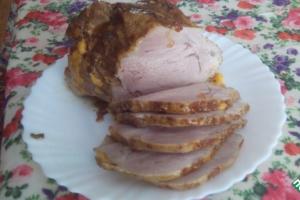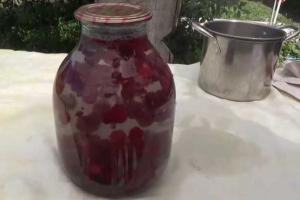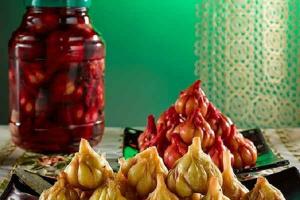First of all, spraying is carried out for protection fruit trees from beetles, butterflies, aphids and caterpillars.
For example, when spraying an apple tree, you can protect the tree from aphids that form nodules on the bark. And if the aphids are not stopped in time, in addition to the apple tree, they will also begin to infect pears, plums, cherry plums and apricots.
That is, the leaves of these trees will first begin to curl, after which they will also fall off.
The plum is also sprayed to protect against the chafer, which eats fruit ovaries and leaves.
In the case of a young garden, the larvae of this insect also damage the roots. The consequence of this may be the death of the entire plant.
Thanks to spraying, apple, plum, pear and cherry trees can preserve not only their leaves, but also their fruits, including during the ripening period, from caterpillars and butterflies.
How to spray trees in autumn and spring?
There are currently a lot of means that can be used to treat a garden. They can be used both in spring and autumn.
But now we will analyze the most popular preparations for spraying trees :
1) Copper sulfate. During summer season This drug is recommended to be used twice. The first time is at the beginning of spring, while the leaves have not yet appeared on the trees, since when it is diluted in the recommended proportions, it can damage young leaves.
 The second time in the fall - after the leaf fall period.
The second time in the fall - after the leaf fall period.
Copper sulfate is also used as disinfectant for wounds on plants.
Typically, this drug is used when processing plums and apple trees (in the fall - at the end of October, in the spring - at the beginning of March).
It is best to spray fruit trees in the morning or evening, in calm weather, at temperatures from +5 to +30 °C.
The consumption rate for one fruit-bearing tree is about 10 liters of ready-made solution, and for a seedling about 2 liters.
Copper sulfate is considered a very aggressive drug, and therefore it is best to dilute it away from people and animals.
You also need to make sure that its remains do not get into the well or other sources of water.
2) Carbamide (urea). Trees are sprayed with urea a week after flowering, and when preparing the trees for the winter period.
Using a urea solution of a weaker concentration (50 g per 10 liters of water), it will be possible to spray the orchard a week after flowering. This way you can fruit trees protect from caterpillars of leaf rollers, honey beetles, flower beetles, aphids, etc.
In autumn, trees are sprayed with urea after more than 40-50% of the foliage has fallen. In this case, the solution should be stronger than during the flowering period (500 g per 10 liters of water).
But you can also wait until the trees completely shed their leaves and apply a solution of more concentrated urea (7-10%), thereby preparing your garden plot for the next season.
In this case, you spray not only the trunks and branches, but also the soil, and therefore this solution will serve as both a fungicide and a fertilizer.
But if you hurry and apply this high-concentration product earlier, it is possible that the leaves of the trees may get burned, and therefore they will fall off ahead of schedule.
This means that the trees will not have time to receive the required amount of nutrients that are so necessary in preparation for the winter period.
3) Iron sulfate. This drug is used twice during the year (in autumn and spring), when the plants begin to turn green and when they are preparing for the winter period.
When spraying plants with copper sulfate, two problems are solved at the same time, that is, the trees receive the iron they need, which plays an important role in the respiration of the plants, but also this drug is an excellent protection against pests.
 If your garden is already old, that is, the trees (pear, apple, plum, etc.) are already old, then be sure to spray this product in early spring and in the fall, which can help you not only with pest control, but also with the destruction of lichen, cytosporosis, moss, septoria, and black cancer.
If your garden is already old, that is, the trees (pear, apple, plum, etc.) are already old, then be sure to spray this product in early spring and in the fall, which can help you not only with pest control, but also with the destruction of lichen, cytosporosis, moss, septoria, and black cancer.
And thanks to this, your trees will be able to accelerate their growth rate and increase yield next year.
4) Preparation 30. This drug is used when spraying apple trees, plums, pears, etc.
It is advisable to use it in early spring and late autumn (200 g per 10 liters of water).
Thanks to the treatment of trees with Preparation 30, you can get rid of whiteflies, leaf rollers, moths, aphids, scale insects, copperheads, red and brown fruit mites, which have been wintering on the bark all this time.
But besides this, this remedy can help you in the fight against larvae in the summer.
According to the manufacturer, this drug is absolutely safe for the tree itself, since when controlling pests, not various substances are used, but a thin film formed after treatment on the tree bark.
That is, pests (in the larval or egg stage) that are treated have their water balance and gas exchange disrupted, thereby creating unfavorable conditions for their existence, which leads to their death.
5) Diesel fuel. Diesel fuel can also be used as for spring processing, thai and in the autumn. But it must be used very carefully. Because if sprayed incorrectly, trees may get burned or, even worse, die.
Therefore, this processing method must be taken with great responsibility.
In the spring, it is best to treat trees with diesel fuel until leaves and buds form, and in the fall, wait until all the leaves fall off.
Diesel oil in its pure form cannot be used for spraying trees. A large amount of water and other substances are added to it that can reduce its destructive activity.
How to spray trees in the fall?
Autumn spraying of trees is an important part of closing the season and preparing garden plot for the winter period. It will be possible to begin this procedure in October - November, that is, when the trees shed their leaves, and therefore the possibility of damage to them by chemicals is excluded.
In preparation for processing, we remove lichens and old bark from trees over 6 years old. By themselves, old bark and lichens cannot harm plants, but pathogens of various diseases and pests can overwinter there.
The most late processing carried out after the first frost, but before that we still need to remove foliage, weeds and fallen branches from the site, that is, everything that has accumulated during the season.
Every owner of a summer house or private home needs to prepare for the winter. Your future arrangement of affairs in the spring depends on this preparation. By treating the garden in the fall from various diseases and pests, you direct your efforts mainly to cleaning up pests and fighting harmful insects, various microorganisms that cause all kinds of diseases, rodents and the influence of weather conditions.
Treatment of a garden in the fall from pests and possible diseases includes several processes aimed mainly at caring for plants of cultivated crops, namely: cutting off old branches, treating plantings with special solutions (spraying with solutions of copper and iron sulfate, urea), whitewashing tree trunks and gartering plants for the winter period. Let's consider the above processes in more detail.
Procedure for pruning with garden shears
At the end of the summer period, every smart gardener knows about the need for preventive pruning garden plants in the garden. For correct pruning remove diseased shoots, fatty deposits and branches growing inside the tree. In different climatic regions, autumn can be delayed and the weather can remain consistently warm for quite a long time. In this regard, a large number of tops appear, which also need to be removed.
If the dacha is located in the northern region, then it is not advisable to carry out pruning in autumn and winter - this can significantly damage the plants and lead to freezing of the bark. For the southern regions, such pruning is acceptable and is especially suitable for young seedlings. Pruning young seedlings is a very scrupulous process and only branches that interfere with the growth of others can be pruned.
When pruning, it is important to observe tiering (all branches located below should be thicker than those above) - this will make it possible to obtain fruits of good quality.
Removing old bark from a tree with a metal scraper
The whitewash mixture can be purchased at the store or made yourself.
Preparation of whitewash
To prepare whitewash, mix the following components one by one:
- 3 kg of lime;
- 0.5 kg copper sulfate;
- 80 grams of casein glue;
- water is added until the mixture is thick enough to resemble sour cream.
 Lime
Lime Second preparation option:
- slaked lime – 2 kg;
- copper sulfate – 250 g;
- clay – 1 kg;
- cow dung.
For whitewashing, you can also use water-based and acrylic paints purchased in stores.
Whitewash effect
Whitewashing trees is useful because, by organizing a protective layer of wood, you get rid of insect pests and microorganisms that carry various viruses. By whitewashing, you also prevent insects from depositing eggs on the trunks. To carry out more effective whitewashing, it is necessary to add vitriol and various types of insecticides to the solution (karbofos is a striking example).

To useful material mixed into one consistency, use glue, paint or clay. If a summer cottage open type and there is a risk negative influence mice and hares on a tree trunk, then you can use carbolic acid, adding them in the amount of one spoon to the whitewash mixture.
Pests that appear during the ripening period can be a huge source of all kinds of diseases in your garden. In order not to succumb to the effects of the poison, chemical treatment plantings during the period before harvesting are prohibited.
Treating the garden with urea
After completing all work in the garden or on summer cottage, trees and shrubs give in special treatment urea solution (5%). Autumn treatment of the garden with urea is necessary to protect plants from scab. Plant branches, their trunks, as well as the soil underneath them can be processed.
Spraying plants with urea. Mandatory protective equipment (respirator, gloves, safety glasses and clothing)One of the constituent elements of urea is urea, which promotes vegetation processes, which leads to the saturation of plants with nitrogen. Spraying can have a negative effect only if a particular plant is not sufficiently adapted to the cold. To prevent the consequences of negative climatic influences, spraying with urea is carried out a month before the onset of cold weather.
When worrying about the safety of your garden plants, don’t forget about yours. Before starting the process, make sure you have a respirator, gloves, work clothes and goggles.
Spraying should be carried out in calm weather in order to prevent the spread of pesticides to places undesirable for treatment.
Treatment with copper sulfate solution
Treating the garden with copper sulfate is done to prevent the appearance of fruit rot, scab and powdery mildew. In order to improve the characteristics of the solution, lime is added to it, resulting in the so-called Bordeaux mixture.
Bordeaux mixtureWhy spraying should be carried out in the fall, the answer is very simple - due to the low temperature, the concentration of the solution can be increased to 3%. If spraying with such a concentration of solution was carried out in spring period, there would be a risk of leaf damage or destruction.
Today, Brodos mixture can be purchased at almost any hardware store. If this is not possible for you for some reason, then you can make it yourself. It is necessary to add 30 grams of copper sulfate to 20 liters of water and dilute with 400 grams of slaked lime.
A fairly good equivalent would be a Burgundy mixture. The only difference is adding 250 grams to it soda ash instead of lime. To ensure that the solution adheres better to the bark of sprayed plants, soap is added to it. It is prohibited to add soap to Bordeaux mixture - this can lead to the formation of lumps.

Treating the garden with copper sulfate is usually carried out after work has been completed (whitewashing, pruning, etc.). In average climatic conditions, the most suitable month for spraying is November. If carried out earlier, this may result in chemical burns of the leaves.
Treatment with iron sulfate
If the plantings are old and they are bothered by problems such as the presence of moss and lichen, then autumn garden treatment iron sulfate a concentration of 5-7% will help get rid of them. The main difference between autumn treatment with iron sulfate and treatment with Bordeaux mixture is that the addition of lime is prohibited.
The effect of treatment with iron sulfate is significantly less than that of previous methods, but it also has its advantages - this is the saturation of trees with iron, and a distinctive effect on oxidation processes.
For the prevention and treatment of certain plant diseases, it is used together with other chemicals for complex therapy of plantings. Insecticides can be added to the solution to repel unwanted pests.
In addition to the above operations, autumn garden treatment includes an equally important procedure - tying up trees. All garden trees with the onset of frost, they are tied with raspberry or spruce branches, and in their absence - with ordinary roofing material or a metal mesh.
Wrapping wood with filmSoil is poured under the resulting structure so that rodents do not harm the tree. The strapping allows you to protect the bark from harsh influences sunlight after the winter period, which can lead to burns. With the onset of winter and in the presence of snow, the latter is poured onto tree trunks.
If you are notified of the presence of rodents in your summer cottage, then autumn treatment of the garden from pests involves the installation of traps, traps and poisoned baits. When falling out large quantity snow precipitation, they are compacted around the tree for greater thermal balance.
After the frost has subsided, around April, all strapping structures are removed. To do this, the weather forecast is analyzed in advance and cloudy days are selected. This is done to better adapt the bark to the influence of ultraviolet radiation emitted by sunlight.
All of the above activities are important for the organization autumn preparation and will protect your soil and plantings from unwanted diseases, climatic influences and will increase overall fertility with yield.
Do fruit trees need to be treated in the fall? Our answer is Yes!
First, you need to clean the tree trunks and the bases of the lower skeletal branches from mosses and lichens, then remove the exfoliated bark. It is advisable to do this in wet weather, and without using any tools (or using non-metal ones), only with gloved hands, so as not to damage the tree trunks themselves.
Spraying and processing of fruit trees is carried out in dry weather, before the onset of frost.
In the fall, it is advisable to treat apple and pear trees for scab. Most effective way To combat this disease is nitrogen spraying. Urea is best suited for this: 500 g is dissolved in 10 liters of water - and go ahead, sprinkle on the trunks and branches.
Also, all fruit trees in the fall need to be watered generously and whitened. The thickness of the whitewash should not be more than 2-3 mm. Whitening is usually done with diluted lime: for young seedlings with delicate bark, a weak solution is prepared; for old trees, the solution should be richer. For example, for young trees take 1 kg of slaked lime per 10 liters of water + 1 kg of clay and 100 grams of copper sulfate (for old trees take 2 kg of lime and a double dose of copper sulfate). If you add another 100 g of cow manure to this whitewash for consistency (you should get the consistency of thick sour cream) and a little finely chopped straw, you will get the so-called clay mash, which is used to cover wounds and cracks on tree trunks. This putty performs protective functions well and does not crack for a long time.
Cracks and wounds on fruit trees can also be covered with garden varnish. You can buy it in the store or prepare it yourself. How to prepare garden varnish: melt 100 g of rosin and 200 g of beeswax separately over low heat, then combine and add 100 g of unsalted fat. After the fat has melted, the mixture must be poured into cold water. That's it, the garden varnish is ready, now you can take it out of the water and roll it into a ball. Before use (for plasticity), it is slightly warmed up. This putty for sealing tree wounds can be stored for a very long time.
It is advisable to prune fruit trees in the fall only in the southern regions, where winters are short and warm. Pruning trees in the northern and middle regions in September-October can lead to freezing of the bark at the cut site, drying out of the wood and, ultimately, to the death of the tree. In these areas, pruning occurs in the spring, usually in mid- to late March.
Treatment of fruit trees in autumn, video
It is necessary to care for plants not only in the warm season, but also in the fall: after harvesting, it’s time to help them survive the winter.
At this time, insects seek shelter for the winter months and often hide in trees and bushes. This leads to the fact that in the spring, after waking up, trees are immediately attacked by voracious awakened insects, many of which also carry diseases.
To prevent such troubles, gardeners carry out regular preventive maintenance twice a year - in the fall, before the onset of cold weather, and in the spring immediately after warming up.
This allows you to save energy and time in the spring to prepare for the new warm season.
Who should you be afraid of?
 Diseases and pests may vary depending on the area and climate.
Diseases and pests may vary depending on the area and climate.
Viruses found on fruit trees and shrubs are especially dangerous:
- Penetrating into the fruits, they can spoil appearance harvest or render it unfit for consumption.
- By destroying the leaves, they force the trees to grow greenery again, leaving no strength for the formation of fruits. This leads to poor quality and low yield.
In Russia, on fruit trees you can most often find:
- fungal diseases: scab, late blight;
- insects that prefer leaves: white moths, bear moths, cocoon moths, moths;
- pests that feed on plant juices: different types aphids (for example, affecting only plums or roses), mites, psyllids, copperhead;
- beetles that attack the reproductive organs: weevils, tubeworms;
- berry pests: Californian scale insect, raspberry beetles, stem nematodes, glass bug, raspberry gall midge.
Note: Despite the abundance of “enemies”, they are mostly destroyed using the same methods, and therefore there is no need to purchase a dozen chemicals at once - you should start with one substance.
 Autumn garden treatment consists of several stages:
Autumn garden treatment consists of several stages:
- harvest;
- pruning branches;
- whitewashing the trunk;
- spraying branches;
- frost protection.
After passing all the points, the garden will be completely ready for wintering.
Harvesting and pruning branches
 After harvesting, it is necessary to ensure that there are no fruits left on the ground in which rot can occur, and all leaves should also be removed. Healthy leftovers can be turned into humus.
After harvesting, it is necessary to ensure that there are no fruits left on the ground in which rot can occur, and all leaves should also be removed. Healthy leftovers can be turned into humus.
To do this, you need to dig a hole in the corner of the garden and throw out all organic parts there. In a few years, they will produce excellent humus, which will be used to fertilize the garden.
Gardener's advice: if diseased fruits or damaged leaves are found, it is necessary to burn them away from healthy plants or bury them.
But pruning can only be done in the south, where the temperature does not drop too low, otherwise the bark around the cut may freeze and the branch will die. If the garden is not in danger of freezing, you need to prune it: remove all dry, crooked and infected branches, and then burn them.
Whitewash
 Whitening trunks with special compounds allows you to solve several problems at once:
Whitening trunks with special compounds allows you to solve several problems at once:
- protects the trunk from ultraviolet radiation in the absence of a crown and shade;
- destroys pests that may try to crawl into the roots;
- regulates heat: thanks to whitewashing, the barrel does not overheat or become overcooled.
For whitewashing, you can use ready-made preparations, choosing the most optimal ones. They adhere well to the bark and do not wear off. They usually contain an antiseptic, which allows for additional disinfection of the surface. The disadvantages of the finished product include their cost.
Please note: if the purchased whitewash is too liquid, you need to add a little PVA glue or garden adhesive to it, but in no case should you use wood glue: it will completely clog the bark and the tree will not be able to breathe.
You can also do whitewashing yourself. The finished product will be less stable, but it will be much cheaper.
For this you can use:
- lime solution: 10 liters of water, 3 kg of slaked lime, 300 grams of copper or iron sulfate;
- 2 parts slaked lime and 1 part clay with the addition of PVA glue for viscosity;
- a mixture of equal proportions of cowshed and clay.
Instead of copper sulfate, you can use Dichlorvos, BI-58, DNOC, as well as the fungicides Hom and Oxychom. It is necessary to adhere to the proportions indicated on the packaging.
Spraying
 After the trunk and bases of the strongest branches have been treated, it is necessary to spray the crown. For this purpose, solutions and special sprayers or sprayers are used.
After the trunk and bases of the strongest branches have been treated, it is necessary to spray the crown. For this purpose, solutions and special sprayers or sprayers are used.
The first ones would be:
- Vitriol solution 1% or 2%: it helps in the fight against rot and various pests.
- One percent Bordeaux mixture: suitable for combating powdery mildew, rot and scab on apple and pear trees. To prepare it, you will need to combine two mixtures: a solution of vitriol (a kilogram of substance per 50 liters of water) and mortar(in the same proportions).
- Soap and soda ash solution: used to prevent powdery rose on gooseberry and currant bushes. To do this, dissolve 50 grams of soda and 40 grams of soda in 10 liters of water. laundry soap– it needs to be grated.
- Urea solution (or carbamide): used to prevent attacks by leaf rollers, aphids, honey beetles and flower beetles. Use according to the instructions on the package.
- Solution mineral fertilizers: 10 liters of water will require 1.5 kg of ammonium sulfate, 0.5 kg of urea and 0.7 kg of nitrate.
Frost protection
 The traditional way to protect trees from frost is to tie them.
The traditional way to protect trees from frost is to tie them.
Suitable for this:
- spruce branches;
- raspberries;
- reed;
- sunflower;
- roofing material: you need to place a rag under it so that it does not touch the bark.
Having covered the trunk with material, it is tied tightly, trying not to crush the trunk of young plants. A good option Wrap the tree over the branches with a metal mesh and secure it: this will help maintain its shape without harming the plant. It is necessary to add soil under the structure to prevent mice from getting inside.
If there are often mice or other rodents in the area, it is necessary to place several traps or poisoned baits around the trees. This will keep the bark intact. Immediately after the onset of spring, everything is removed.
Preparing a garden for winter is not difficult, but it is necessary for anyone who would like to maintain the health of trees and shrubs. Having treated them in advance against pests and diseases, in the spring you can not be afraid of unpleasant surprises.
To do everything correctly, it is recommended to watch training videos and photos in advance, as well as purchase everything you need. Treatment should begin immediately after leaf fall and end before the onset of cold weather. If autumn is late, the work may be delayed a little.
Watch the video in which a specialist talks in detail about autumn processing garden from pests and diseases:








